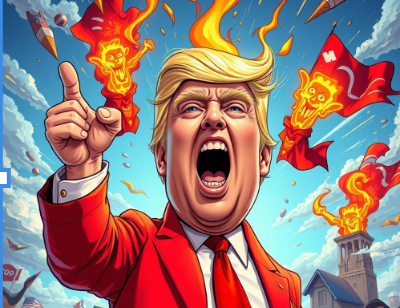$SPY $CADUSD $MXNUSD
#Tariffs #TradeWar #Mexico #Canada #USD #Trump #StockMarket #Economy #Investing #Forex #Commodities #Manufacturing
The United States is once again positioning itself for a potential trade dispute with its closest neighbors, as President Donald Trump signaled that tariffs on Canada and Mexico, which had been temporarily paused, will proceed. This development follows previous tariff threats that created uncertainty in markets and disrupted trade relations. Investors are closely watching the situation, as any escalation could impact key industries, including automotive, agriculture, and manufacturing, which rely on cross-border supply chains. The announcement has reignited concerns about rising costs for U.S. businesses, potentially leading to inflationary pressures, weaker corporate earnings, and volatility in stock markets.
Market reaction to the renewed tariff threats has been swift, with the U.S. dollar seeing strengthened demand as investors seek safe-haven assets amid trade uncertainty. At the same time, the Canadian dollar ($CADUSD) and the Mexican peso ($MXNUSD) have faced increased selling pressure. Prolonged trade tensions could lead to slower economic growth within the North American region, with businesses adjusting their supply chains to mitigate potential costs. Notably, automakers with complex manufacturing processes across all three countries, such as General Motors and Ford, may experience production disruptions, leading to increased expenses that could ultimately be passed on to consumers.
In addition to the direct implications for trade, the move also underscores the broader theme of protectionist policies under Trump’s administration, which have historically caused volatility in financial markets. The stock market, represented by the S&P 500 ETF ($SPY), has remained sensitive to trade policy shifts, with previous tariff disputes between the U.S. and China sparking significant market swings. Investors will now assess potential risks in other sectors, particularly commodities, as trade barriers can impact supply and demand dynamics in oil, steel, and agricultural goods.
While the announcement has injected uncertainty into markets, analysts believe there could still be room for negotiations. Past tariff threats have often resulted in last-minute revisions or diplomatic compromises, minimizing economic disruptions. Nevertheless, businesses may preemptively adjust their strategies, opting for alternative suppliers or production locations. If tariffs are fully implemented, consumers could see price increases on a range of products, from automobiles to food items. In the coming weeks, markets will focus on further trade policy developments, with investors weighing risks against broader economic indicators such as employment data, inflation trends, and corporate earnings results.







Comments are closed.